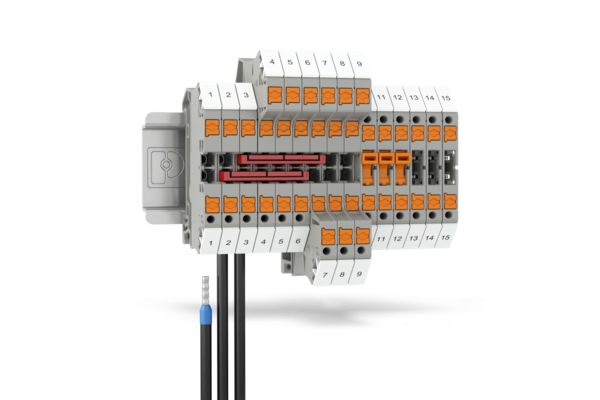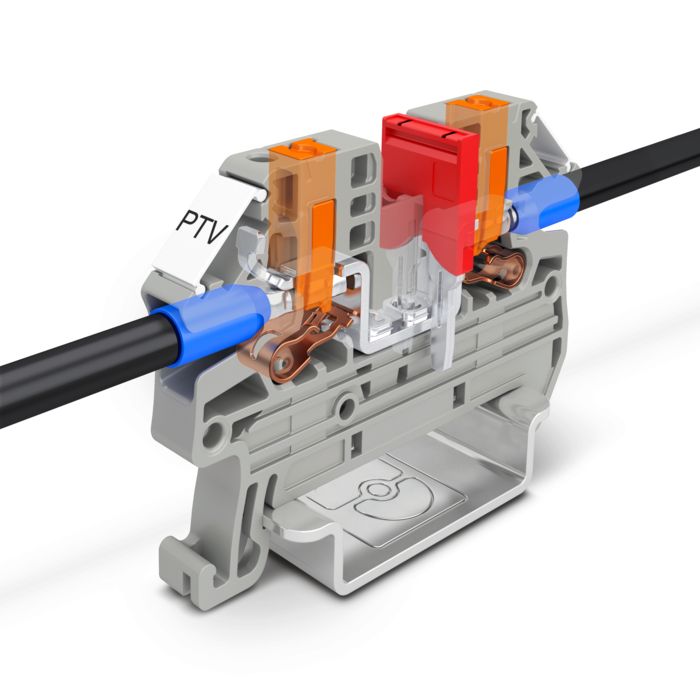
The PTV terminal block family
The PTV terminal block family combines the advantages of tool-free Push-in connection with the lateral conductor routing of a screw terminal block. The PTV terminal blocks thus offer direct, fast connection technology and clearly arranged wiring without bending radii in a single terminal block.
Your advantages
- Affixing and reading off the conductor and connection marking is simple
- Clearly arranged wiring without bending radii
- Time-saving and maintenance-free conductor connection with tool-free Push-in direct connection technology
- The conductor can be easily released without special tools
- Torque-independent contact quality with the spring contact
- The control cabinet layout for the screw terminal block wiring can often be re-used thanks to the lateral conductor feed-ins
- Use of CLIPLINE complete accessories

Lateral Push-in connection
Push-in technology
With PTV terminal blocks, you can connect rigid conductors or those fitted with ferrules directly and without using any tools. The spring profile allows you to connect rigid conductors from 0.5 mm² easily and without tools. The contact spring is opened automatically when the conductor is pushed in, thus ensuring the required pressure force.
Flexible conductors with a cross-section of 0.14 mm² and above without ferrules can be connected with the help of the push button. Regardless of which listed conductor size you use, the contact spring ensures maximum contact and conductor pull-out forces with a vibration-resistant, gas-tight connection. Moreover, the high-quality, hard-faced copper alloy ensures the lowest contact resistances and maximum current transfer.

Feed-through and multi-conductor terminal blocks
Feed-through and multi-conductor terminal blocks
Feed-through terminal blocks and multi-conductor terminal blocks feature a compact design. The terminal blocks can be bridged flexibly and marked quickly and easily. In addition, the terminals can be checked quickly and easily via their test points or in the function shaft. This makes these terminal blocks true universal connection technology.

Double-level terminal blocks with offset levels
Double-level terminal blocks
The double-level terminal blocks are likewise very compact terminal blocks with which you can route two potentials in parallel. The double-level terminal blocks can be connected both horizontally and vertically with the double function shaft and various bridging versions. This allows not only nearby terminal blocks to be connected, but also the various levels.
The double-level terminal blocks also have an offset level. This offset enables unhindered access to the lower connection levels and push buttons even when fully wired.

Fuse terminal blocks
Fuse terminal blocks
PTV fuse terminal blocks enable type G 5 x 20 fuses to be integrated into your system, saving space and ensuring clarity. The pivoting lever allows you to replace the fuses quickly and conveniently.
With the optical indicators, faulty fuses are quickly identified, regardless of the current direction. With the lateral conductor connection, you can fully open the levers of the fuse terminal blocks without problems, even when conductors are connected.

Disconnect and knife disconnect terminal blocks
Disconnect and knife disconnect terminal blocks
Where space is restricted, PTV disconnect terminal blocks with lateral conductor connection enable the clear separation of signal currents. The product portfolio of these terminal blocks consists of versions with function shaft and versions without function shaft.
The circuits of knife disconnect terminal blocks can be opened easily with a standard screwdriver. The disconnect lever latches into the end positions, ensuring that the switching states of the knife disconnect terminal blocks are permanently secured and always clearly detected. PTV disconnect terminal blocks, on the other hand, feature a disconnect zone in which various function plugs can be installed without tools.
To ensure an ideal testing option despite assembled function shaft, the terminal blocks feature double-sided test points. These test points guarantee an easy and safe testing option. The flat contact on the current bar ensures reliable test results.

Multifunctional disconnect zone
Multifunctional disconnect zone
PTV disconnect terminal blocks have a standardized disconnect zone. The disconnect zone accommodates various connectors such as fuse plugs, component connectors, feed-through connectors, and isolating plugs. This versatility allows you to customize your switching devices. Use the function plugs. Turn a disconnect terminal block into a component terminal block, fuse terminal block, or feed-through terminal block quickly and easily.

Test-disconnect terminal blocks with integrated test sockets
Test-disconnect terminal blocks
The PTVME 6/S… products are test-disconnect terminal blocks with vertical Push-in connection. They can be used in all applications on the secondary wiring side of switching devices for transducers and signals. With a nominal voltage of 1,000 V and a nominal current of 30 A, the transformer terminal blocks feature increased sparkover and disruptive discharge resistance.
The two terminal block versions differ in the area of the test sockets. The ... 6/S version can be extended with test sockets as optional accessories. The ... 6/S-P version already has the 4 mm test sockets integrated as standard ex-works.
Which version you decide upon will depend upon your priorities. With the version with integrated test sockets, you will save time and money when configuring your wiring. With the version without integrated test sockets, you can install the insulated test sockets from Phoenix Contact. This also makes testing and measuring tasks possible with contact-proof measurement lines in accordance with IEC EN 61010-031.

Type 2 Push-in surge protection
Type 2 Push-in surge protection
The VAL-MS PT is the first type 2 surge protective device in the world with Push-in connection technology. The PTV is integrated into the surge protective device, thus providing the proven advantages during installation in this field as well. Testing the recommended nominal tightening torque is a thing of the past.
Through-wiring also saves further costs, because no additional installation material is necessary. Use the optional remote indication contact, which is also easy to install with through-wiring, to ensure that the protective devices are monitored.
